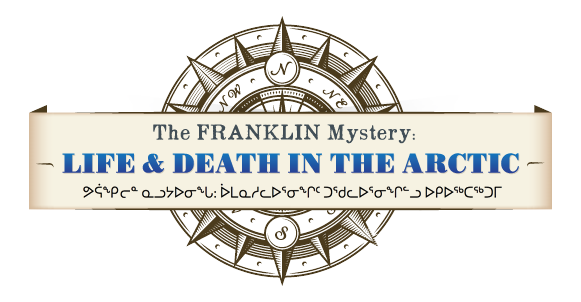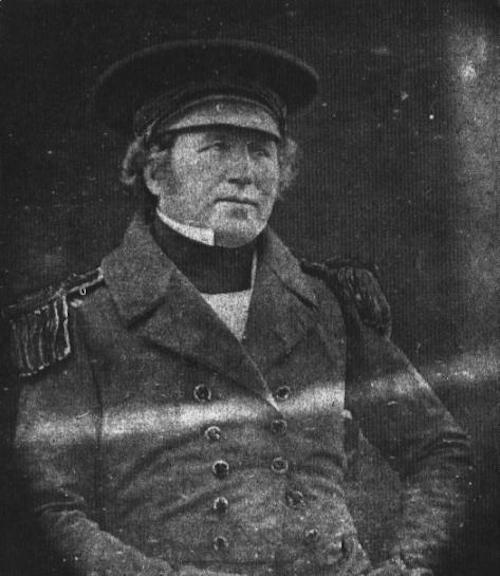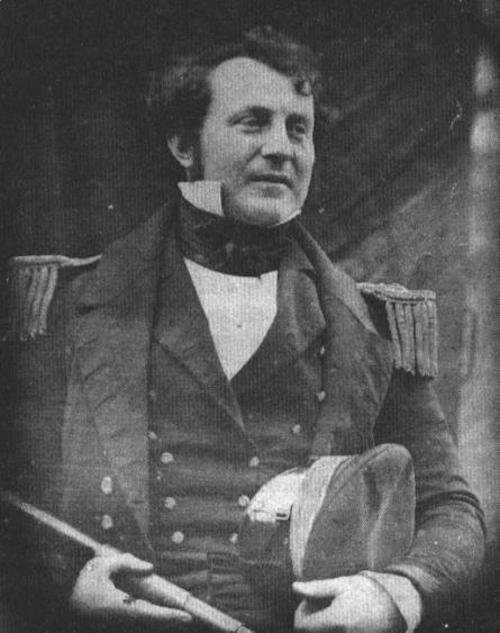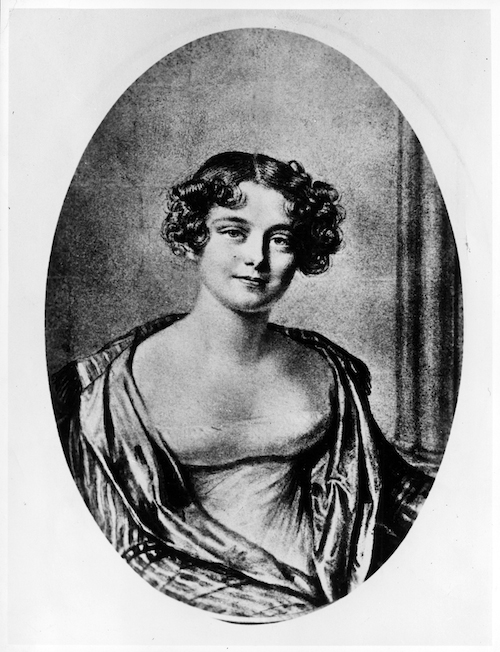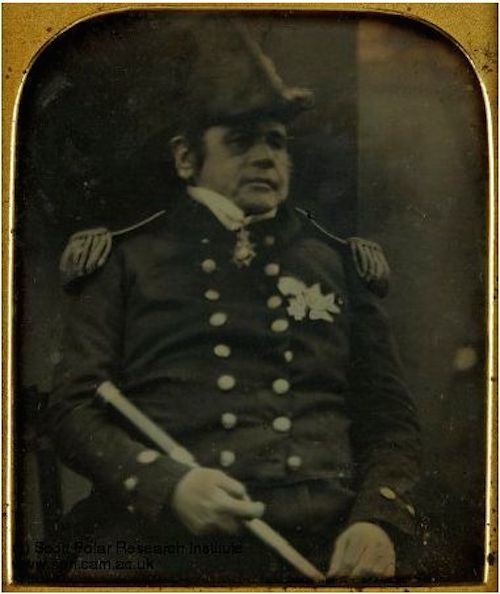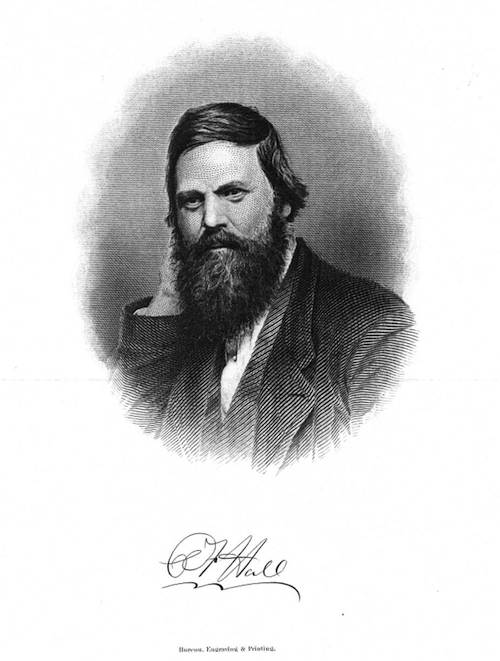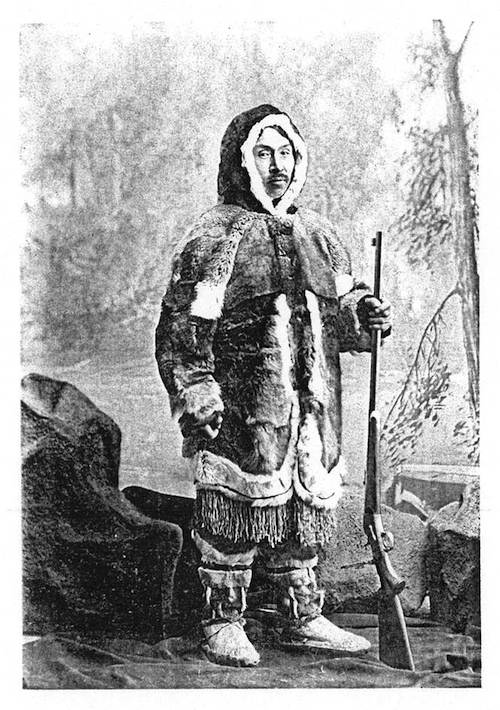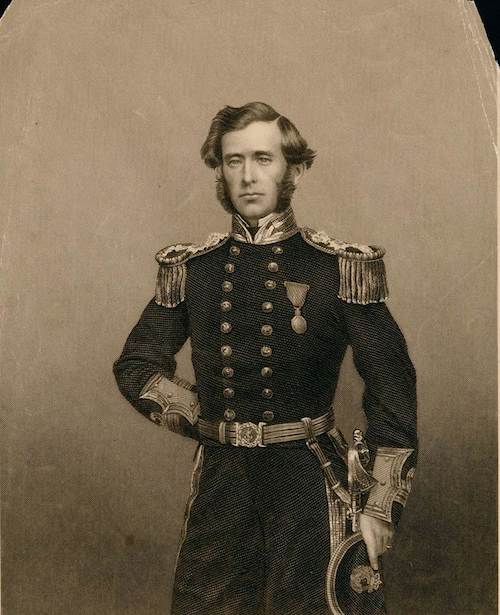Characters
This section contains brief biographies of these major characters (in alphabetical order) :
- Crozier, Francis (1796-1848?)
- Fitzjames, James (1813-1848?)
- Franklin, Lady Jane (1791-1875)
- Franklin, Sir John (1786-1847)
- Hall, Charles Francis (1821-1871)
- Innookpoozhejook (ca. 1869)
- Ipirvik (ca. 1837-1881) and Taqulittuq (ca. 1838-1876)
- Irving, John (1815-1848?)
- McClintock, Sir Francis Leopold (1819-1907)
Francis Crozier (1796-1848?)
Captain of the Terror and second in command of the Arctic expedition, Crozier was already a seasoned Arctic mariner by the time he was appointed second in command on Franklin's last expedition. Like many naval officers of that era, he was unmarried. In 1843 he was elected a Fellow of the Royal Society in recognition of his work on geomagnetism. Along with James Fitzjames, Crozier signed a note on an expedition record dated 25 April 1848 stating that they and their men had abandoned their vessels Erebus and Terror and would then initiate a trek towards the Great Fish River on the North America mainland. Where Crozier and his party went after depositing that record and what happened to them are among the key issues of the mystery of the expedition.
James Fitzjames (1813-1848?)
Third in command on the Arctic expedition after Franklin and Crozier, Fitzjames was a career mariner although his naval experience was largely military rather than exploratory. He had served on various British naval campaigns in Syria, Egypt and China. When he was appointed to the Arctic expedition, Franklin gave Fitzjames responsibilities for recruitment and also for overseeing the magnetic observations that were an important part of the expedition's objectives.
Lady Jane Franklin (1791-1875)
Wedded to John Franklin in 1828, Jane (Griffin) Franklin was a strong partner of her husband throughout his subsequent naval career and governorship of Van Diemen's Land. When his third Arctic expedition failed to return by 1847, she initiated tireless efforts to press British and American governments to search for his missing party. Seven of these expeditions were sponsored by her directly. When Dr. John Rae returned to England with news of the fate of the Franklin party, including their alleged resort to cannibalism, Jane Franklin mounted major efforts to deny not only these claims but also Rae's claim to the Arctic reward. She then focussed her efforts on enlisting official commemoration of her husband's achievements, including the installation of a bronze statue of Sir John Franklin at Waterloo Place in London.
Sir John Franklin (1786-1847)
Sir John Franklin came to the command of his third Arctic expedition at the age of 59. A seasoned naval officer who had fought in various battles commanded by Admiral Horatio Nelson, Franklin had commanded two previous Arctic expeditions when his ships departed England in 1845.
After his narrow escape in his first expedition to the Arctic between 1819-22, during which he experienced severe hardships, he became known as "the man who ate his boots," a nickname acknowledged in correspondence with his sister Isabella Cracroft. Following his Arctic service and other military assignments, he was appointed lieutenant governor of Van Diemen's Land, now the state of Tasmania in Australia.
Throughout his career he was an accomplished navigator and scientist, and he carried out extensive mapping and magnetic observations on all of his exploratory missions. Well-liked by his colleagues and a devout Christian, Franklin was known for his concern for the well-being of members of his exploration parties.
Charles Francis Hall (1821-1871)
An American journalist, Hall became interested in the Arctic and in particular Franklin's missing expedition in the late 1850s. He then staged two expeditions in search of evidence of Franklin's missing party, beginning with a voyage to Baffin Island, where he secured what he thought was evidence of the possible survival of members of Franklin's party. His searches culminated during his second Arctic expedition when he spent five years with Inuit at Repulse Bay, Igloolik and other areas. During his summer 1869 sledge excursion accompanied by Inuit to King William Island he obtained significant evidence of the fate of Franklin's party and their ships, and collected various Franklin artefacts from the Inuit.
Innookpoozhejook (ca. 1869)
A member of the Netsilingmiut from the area of Pelly Bay, Innookpoozhejook became one of the most important informants providing data on the fate of the missing Franklin expedition. After meeting Dr. John Rae during his second Franklin search expedition, Innookpoozhejook later provided extensive information and knowledge about the Franklin party and ships in a series of interviews with Charles Francis Hall in 1869. In addition, he drafted a map of the sites of Franklin evidence in and around King William Island, which remains a key source for understanding what happened to the party. His powers of observation and memory were remarkable, as attested to by Hall and evident in his reported conversations with the explorer.
Ipirvik (ca. 1837-1881) and Taqulittuq (ca. 1838-1876)
Ipirvik and Taqulittuq from Baffin island (Kikiqtaaluk) served as guides on various polar expeditions, beginning in the early 1860s, when Ipirvik and his spouse Taqulittuq assisted Charles Francis Hall during his first expedition in search of evidence of the missing Franklin party. Between 1864 and 1871 they joined Hall for his second expedition, culminating in their 1869 overland trip to King William Island, where they learned many details of the fate of Franklin and his party. Ipirvik's hunting, Taqulittuq's sewing, and their service as guides and interpreters enabled Hall to survive, collect extensive oral history data, and bring back the evidence and Franklin artefacts to the United States.
John Irving (1815-1848?)
Third Officer on HMS Terror, John Irving left letters poignantly documenting the experience of a junior officer during Franklin's last expedition. Born in Edinburgh, he attended the Royal Naval College before embarking on a naval career in 1831. An evangelical Christian and devoted to his family, Irving was a member of the party departing the ships in 1847 whose personal objects were subsequently retrieved by search expeditions. Based on this evidence, Frederick Schwatka thought his party had discovered Irving's grave in 1880, retrieved the remains, and they were re-interred in Scotland following his funeral in 1881.
Sir Francis Leopold McClintock (1819-1907)
An Irish officer in the Royal Navy, McClintock became a seasoned Arctic traveller through service on a series of Franklin search expeditions. These included Henry Kellett's expedition of 1852-54, when McClintock famously travelled 1,400 miles by sled and charted 800 miles of coastline. In 1857, he was engaged by Lady Franklin to command her privately-funded expedition in the Fox. McClintock`s party retrieved the principal written record of the Franklin party at Point Victory on King William Island, intelligence from the Netsilingmiut of the fate of the ships, and other evidence of the missing sailors. Later, he weighed in to support Lady Franklin in her efforts to try to refute the mounting evidence of cannibalism among Franklin's men.

